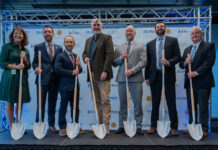By the BF Staff
From the September/October 2016 Issue
Seven regions across the Hoosier State are participating in the Indiana Regional Cities Initiative, which will be eligible for review by the Strategic Review Committee for state matching funds. Together, these plans total more than $3.78 billion in public/private investments for more than 400 cultural and livability projects in Indiana.
Spearheaded by Gov. Mike Pence, the Indiana Regional Cities Initiative sets a framework for neighboring communities across the state to work together to develop regional visions that are supported by compelling strategic plans focused on quality of place. The initiative is helping each region develop a positive and unique national brand to advance the goal of becoming a destination for talent. The initiative is overseen by the Indiana Economic Development Corporation.
The regions that comprise the Regional Cities Initiative are:
Central: The region’s priority projects include a 35-mile Bus Rapid Transit (BRT) line dubbed the Red Line, a 60-acre tech and innovation district, and enhanced trails and pathways to advance the region’s quality of life. Together, these projects will total more than $597 million in investments.
East Central: The east central ADVANCE region’s plans, which total more than $147.9 million in investment, include continued revitalization of Muncie’s downtown area and development along the White River, as well as New Castle’s up-and-coming arts district.
North Central: The northern Indiana region’s quality of place initiatives, which total $731.5 million in investment, include revitalization of the former Studebaker Plant in South Bend, investment in Wellfield Gardens in Elkhart and continued collaborative initiatives with the University of Notre Dame.
Northeast: This Road to One Million vision aims to grow the northeast region’s population from 789,015 to 1,000,000 residents by retaining and attracting a young, more educated workforce. The region’s proposal includes 38 projects to be implemented in the next two years, including development along the St. Mary’s River in Fort Wayne, revitalization of the former Clyde Theater and a new 45,000-square-foot Food Innovation Center in Bluffton. The proposal totals more than $842 million in regional investments.
Northwest: The northwest region plans to invest more than $509.4 million through projects including significant improvements to the South Shore Line to improve access and convenience while capitalizing on Chicago’s commuting population.
Southwest: The southwest region’s plans, which total $926.3 million in investments, include a Science Center at the Signature School, residential development in Evansville’s city center and gateway projects like the Warrick Country Wellness Trail.
West Central: The Wabash River Region’s investment plans total approximately $34 million and include renovations of the historic New Moon Theatre in Vincennes as well as transformation of the 180,000-square-foot ICON building along the Wabash in Vigo County to include working space, amenities and housing for entrepreneurs.
A RENAISSANCE IN SOUTH BEND
North Central Indiana recently broke ground on the Studebaker Factory Buildings redevelopment in South Bend, one of the region’s marquee projects outlined in its “Innovate Indiana” plan submitted for state funding through the Indiana Regional Cities Initiative.

The four-phase, $165.7 million project will anchor the establishment of South Bend’s Renaissance District and, once complete, is set to be the largest mixed-use technology campus in the Midwest. The adaptive reuse of the former Studebaker campus, which totals 1.1 million square feet of real estate on 30 acres, will create a concentrated hub for education and innovation with the potential to house more than 3,000 technology workers, serve more than 7,100 students in workforce development capacities, and facilitate nearly 800 internships each year.
“South Bend and the surrounding region have a rich heritage of innovation, starting with Clem and Henry Studebaker opening their first company here in the mid-1800s,” said Governor Mike Pence. “This bold project continues that trend, making old new again and creating an opportunity to advance entrepreneurship, education and workforce development in Indiana. The redevelopment of this mile-long campus will transform the North Central region, fueling innovation while attracting new business and top talent to the Hoosier state for years to come.”
Officials broke ground on renovations of Building 112 and Building 113, which will be transformed into a 220,000-square-foot space dedicated to entrepreneurship and STEM programming, housing multiple tenants specializing in advanced manufacturing, life sciences, technology, education and workforce development in addition to space for co-working and retail. The initial work will provide needed renovations and address infrastructure issues related to the historic site, which has remained largely vacant since Studebaker ceased auto production in South Bend in 1963.
“Our region has already benefited immensely from the collaboration required to develop a bold vision for the future,” said John Affleck-Graves, executive vice president of the University of Notre Dame and chair of the Northern Indiana RDA board. “The Renaissance District, including the renovation of historic Studebaker Building 113, was identified as a marquee project in that vision. And today, we’re thrilled to be breaking ground at this historic site where the promise of innovation will once again be shared with our entire region. On behalf of the RDA, and the half million men, women and children we represent throughout Elkhart, Marshall and St. Joseph counties, thank you, congratulations, and let’s continue working together to support a growing, innovation-based economy that attracts more and more talented people to North Central Indiana.”
By the end of 2016, building renovations will be complete and the first floor will be a fully-functioning innovation center, home to several entrepreneurial and technology ventures. Initial tenants, which will begin moving into the facility this summer, include:
CupPrint: An Ireland-based company that utilizes the latest technology to print customized paper cups in a quick and cost-effective way.
enFocus: A non-profit that partners with local businesses to create fellowship opportunities for recent graduates.
F Cubed (F3): Develops rapid, DNA-based molecular diagnostic devices and test kits used for environmental, food safety, medical diagnostics and oil and gas applications.
South Bend Code School: Provides training and web development skills needed to obtain tech jobs.
Trek10: Develops and manages cloud-based computing for businesses, providing increased efficiency and flexibility while reducing infrastructure costs.
These initial renovations will pave the way for future phases of development in Buildings 112 and 113, which will include collaborative educational initiatives on the second floor of the facility.
“South Bend is ready to take full advantage of what we’ve always had going for us, a tradition of innovation, excellence in workmanship, the resources of a world-class research university, and a distinctive location surrounded by highways, crisscrossed by rail and situated between several of the Midwest’s largest cities,” said South Bend Mayor Pete Buttigieg. “With these assets, South Bend is prepared to make good on our potential by rehabilitating former Studebaker buildings into centers for technology companies and related educational programs.”
The Indiana Regional Cities Initiative is helping communities across Indiana come together to transform their regions into nationally-recognized destinations to live, work and play. North Central Indiana is one of three regions selected by the state for phase one funding at $42 million each in order to advance quality of place projects. The region’s “Innovate Indiana” plan outlines 39 quality of place projects throughout Elkhart, Marshall and St. Joseph counties totaling more than $703 million in combined public and private investment.
“This is a bright new beginning,” said Kevin Smith, building owner and Renaissance District project leader. Smith is the founder and chief executive officer of Global Access Point, which operates the data center at Union Station Technology Center. “At one time, we produced cars sold around the world in these buildings. Now, from the same place, we’ll be a beacon of light and a source of innovation for the world.”
The region’s RDA is responsible for finalizing how funding will be dispersed throughout the region; it is expected that state funds awarded through the Indiana Regional Cities Initiative will be allocated toward the redevelopment of the Studebaker campus. In addition to the Studebaker project, North Central Indiana’s regional development plan includes improvements to the South Shore rail service, redevelopments to East Bank Village along the St. Joseph River and the revitalization of Elkhart’s Market District.
ADVANCED AUTO SECTOR REVS UP
Indiana’s advanced auto manufacturing is powering investment and fueling expansion throughout the state. And with several projects underway, or nearing completion, the Hoosier Energy network is hard at work providing the infrastructure and electric power to bring new facilities online.
Hoosier Energy and its 18-member distribution cooperatives, which serve central and southern Indiana and southeastern Illinois, have worked to build a platform that provides new facilities reliable power from groundbreaking to full production capacity.
“We are always planning for future need and the next project,” said Hoosier Energy Key Accounts Manager Jim Wittman. “Our first priority is to ensure that the infrastructure is in place to springboard the expansion that we are seeing in our area.”
From green-space planning and shovel-ready sites to providing real-time monitoring, remote closures at substations, and constant communication with rural electric member cooperatives (REMCs) to allocate power for regional power demands, Hoosier Energy’s approach is proactive and serves as a catalyst for economic growth.
Auto manufacturers invested more than $250 million in REMC-served sites and facilities in south central Indiana alone in 2015 and 2016. With the industry showing no signs of slowing, Wittman added that the REMCs are invested in seamless and successful implementation of services for expansions and new facilities. “Their engineers and technicians live and work in these communities and serve as advocates for growing their local economy,” he said.
Hoosier Energy staff and the REMC managers coordinate closely with clients to quickly and efficiently provide reliable power at a competitive cost. The Hoosier Energy team negotiates agreements with companies detailing expansion needs and costs, rate options incentives, as well as the time periods needed for construction and delivery.
“Hoosier Energy’s economic development and engineering team members collaborate extensively with REMC managers and staff on both new-attraction and existing-expansion projects, particularly those projects that require new or expanded electric transmission facilities,” said Chuck Martindale, Hoosier Energy senior economic coordinator.
Part of the stellar success of the industry in this part of the state is attributed to thriving communities like Mooresville, Columbus, and Greensburg with proven track records of supporting company expansion and re-location. The abundant interstate, highway and rail access as well as Indiana’s pro-business climate and favorable tax rates are also very desirable to both domestic and foreign investment.
TOA (USA) has undertaken three significant construction projects in Mooresville, Indiana, and has invested a total of $111.2 million into its facility, bringing 300 new jobs into the community. When all projects are completed, TOA (USA) will have nearly 1,000 employees working in 1 million square feet of facilities.
As a major a supplier to Subaru and Toyota, TOA specializes in frame and automotive suspension parts manufacturing. Founded in 2000, the manufacturer’s Mooresville facility is the company’s first and only auto-parts manufacturing plant in the United States.
“TOA’s expansions help our community grow because the growth of its workforce results in additional payroll, taxes and consumer needs in the economy,” said Mike Dellinger, Morgan County Economic Development Corporation executive director. “TOA’s growth exemplifies to other businesses that the workforce is productive and that business costs are reasonable and competitive when compared with other Midwest metropolitan locations.
Toyota Industrial Equipment Manufacturing (TIEM) has a new $16 million expansion and building renovation at its forklift manufacturing plant in Columbus, Indiana. The 50,600-square-foot addition will increase the total facility to 1.1 million square feet of manufacturing and support space.
The expansion includes a two-story office building, cafeteria, storm shelter, locker room and expansion space for Toyota’s onsite medical center for associates and their families. The new building will also serve as headquarters for Toyota Material Handling North America.
Also in Columbus, global emissions control technology giant Faurecia has a new $64 million facility that figures to be a launching point for what the company is calling their 4.0 manufacturing initiative. The facility’s operations are being touted as a possible blueprint for the future of digital manufacturing.
The 400,000-square-foot plant will produce a new, high-tech emission control product for Cummins in a digital environment—a facility that will use robotics, automated robotic vehicles and visual communication techniques designed to foster collaboration and communication from management to the manufacturing floor.
Honda Manufacturing of Indiana (HMIN) in Greensburg, Indiana is investing $52 million to expand its plant to support production startup early next year of the Honda CR-V compact SUV, and the establishment of a training center for its employees.
Specifically, HMIN is investing approximately $40 million to enhance manufacturing flexibility and production capabilities of its existing 1.3 million-square-foot plant, and will invest an additional $12.37 million toward its new 20,000-square-foot Associate Resource Center. The capital investment in HMIN now exceeds $900 million, and the plant provides employment for over 2,300 associates.
Yet another investment in Greensburg comes at Valeo Engine Cooling, Inc., a global manufacturer of engine cooling loop exchangers and modules; change air, exhaust gas, and oil coolers; and front end modules. Valeo invested $22 million in the Greensburg operation to upgrade equipment and to hire 25 more employees. The company has invested about $128 million in for this site in the last decade, and the local campus employs 700 full-time and about 220 part-time staff.
Hoosier Energy Manager of Economic Development & Key Accounts Harold Gutzwiller is quick to point out a common thread among TOA, TIEM, Faurecia, HMIN, and Valeo. “Automotive companies continue to reinvest in our communities not only because of our central location and great business environment but because of our strong workforce which continues to be among the most productive in the U.S.”
A strong automotive manufacturing heritage is celebrated in communities throughout the Hoosier Energy network. From one generation to the next, manufacturing skills and technical acumen are passed on creating a highly-skilled manufacturing workforce which complements its prime geographic location, and top notch electric utility infrastructure. With this mix of desirable attributes, central and southern Indiana and southeastern Illinois are primed for continued automotive manufacturing success.
Hoosier Energy is a generation and transmission cooperative (G&T) with headquarters in Bloomington, Indiana. The G&T provides electric power and services to 18 electric distribution cooperatives in southern and central Indiana and southeastern Illinois. Hoosier Energy operates the coal-fired Merom Generating Station, three natural gas power plants, several renewable energy facilities and a 1,700-mile transmission network. For more information, visit www.hepn.com.















![[VIDEO] Get More for Your Business in Ardmore. Oklahoma](https://businessfacilities.com/wp-content/uploads/2024/02/maxresdefault-324x160.jpg)
